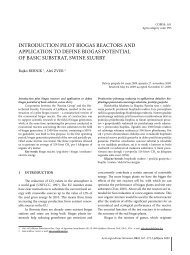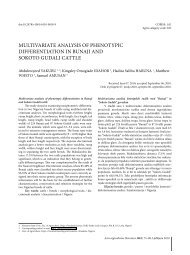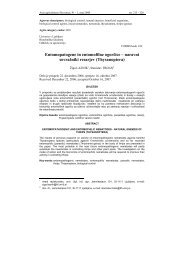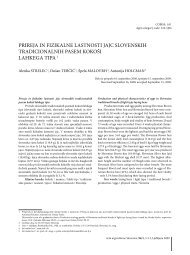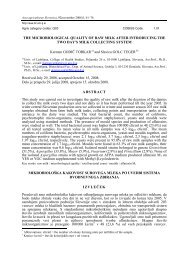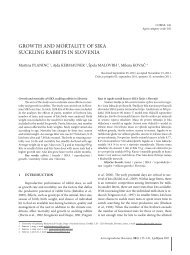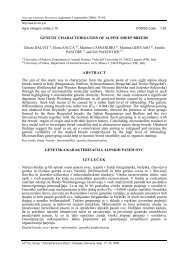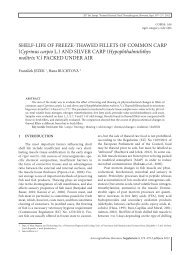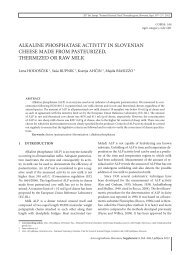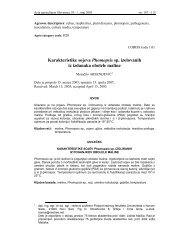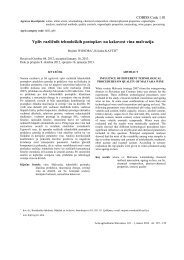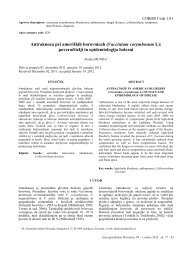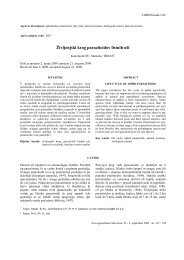MILK PRODUCTION OF BOVŠKA SHEEP IN CONVENTIONAL AND ...
MILK PRODUCTION OF BOVŠKA SHEEP IN CONVENTIONAL AND ...
MILK PRODUCTION OF BOVŠKA SHEEP IN CONVENTIONAL AND ...
You also want an ePaper? Increase the reach of your titles
YUMPU automatically turns print PDFs into web optimized ePapers that Google loves.
Acta agriculturae Slovenica, suplement 2 (september 2008), 41–46.<br />
http://aas.bf.uni-lj.si<br />
Agris category codes: L01 COBISS Code 1.08<br />
<strong>MILK</strong> <strong>PRODUCTION</strong> <strong>OF</strong> <strong>BOVŠKA</strong> <strong>SHEEP</strong> <strong>IN</strong> <strong>CONVENTIONAL</strong> <strong>AND</strong> ORGANIC<br />
FARM<strong>IN</strong>G SYSTEM<br />
Miran KASTELIC and Dragomir KOMPAN<br />
a) Univ. of Ljubljana, Biotechnical Fac., Dept. of Animal Science, Groblje 3, SI-1230 Domžale, Slovenia<br />
ABSTRACT<br />
The productivity of Slovenian autochthonous dairy sheep breed Bovška in conventional and<br />
organic farming was studied. Bovška breed sheep are concentrated in western part of Julian Alps<br />
in Trenta valley. Animals from conventional system produce around eighteen percent more milk,<br />
fat, proteins and lactose. The system of production does not affect milk composition with<br />
exception of lactose. The flocks which entered organic farming scheme had lower level of<br />
production before the organic farming was officially introduced to Slovenia – the organic<br />
farming was the choice of low input farmers. In organic and conventional production the most<br />
important effect is that of flock. According to mentioned results and results from literature, there<br />
are many possibilities for moderate improving of productivity in conventional and organic<br />
farming.<br />
Key words: dairy sheep / productivity / milk composition / organic farming / conventional farming / Slovenia<br />
MLEČNOST BOVŠKE OVCE V KONVENCIONALNEM <strong>IN</strong> EKOLOŠKEM NAČ<strong>IN</strong>U<br />
REJE<br />
IZVLEČEK<br />
Proučevali smo proizvodnost slovenske avtohtone mlečne pasme bovška ovca v konvencionalni<br />
in ekološki reji. Večina ovc je v zahodnem delu Julijskih Alp v dolini Trente. Živali iz<br />
konvencionalne reje priredijo približno osemnajst odstotkov več mleka, maščob, beljakovin in<br />
laktoze. Način reje ni vplival na sestavo mleka z izjemo laktoze. Tropi iz ekološke reje so imeli<br />
manjšo proizvodnost, tudi preden je bila ekološka reja vpeljana v Slovenijo. Ekološki način reje<br />
so izbrali rejci, ki so že prej kmetovali ekstenzivno. Tako v ekološki kot v konvencionalni prireji<br />
je bil najpomembnejši vpliv črede. Glede na ta rezultat in rezultate iz literature obstaja precej<br />
možnosti za izboljšanje proizvodnosti tako v konvencionalni kot v ekološki prireji.<br />
Ključne besede: mlečne ovce / proizvodnost / mleko / sestava / ekološka prireja / konvencionalna prireja / Slovenija<br />
<strong>IN</strong>TRODUCTION<br />
Bovška Sheep is an autochthonous dairy sheep breed. The breed is mostly reared in some<br />
Slovenian remote areas in Julian Alps. Animals are traditionally reared on relatively low input<br />
production system. Organic farming is nowadays becoming more and more popular also in<br />
Slovenia. Many farmers, among them also the Bovška sheep breeders found such management as<br />
an opportunity. They joined the Slovenian agricultural environmental program which is<br />
supported with the subsidies.<br />
The productivity of dairy sheep reared in organic farming was not very widely studied. Dairy<br />
sheep are, especially in poor land conditions, reared in extensive or semi-intensive conditions in<br />
traditional way (Stefanakis et al., 2007). In such conditions the organic farming is in many cases<br />
only “formalization” of the currently used management. In North European countries with better<br />
16 th Int. Symp. “Animal Science Days”, Strunjan, Slovenia, Sept. 17–19, 2008.
42<br />
Acta agriculturae Slovenica, suplement 2 (september 2008).<br />
farming conditions, cattle is used for milk production. The differences between the productivity<br />
and milk composition of conventional and organic farming were done on case studies. Results<br />
are different from case to case. Nauta et al. (2006) found the production of 6 440 kg of milk per<br />
cow and lactation in organic and 7 156 kg milk in conventional management in the same<br />
geographic area. Farms which are in the phase of convertion from conventional to organic<br />
farming had an average production of 6 622 kg per cow and lactation. It is interesting that the<br />
average preorganic production was lower (6 991 kg / cow and lactation) than on the conventional<br />
farms. After the farms started to convert to organic management, the percentage of proteins<br />
dropped. The diet on organic farms is based on fiber forages, but the percentage of fat is a little<br />
lower on organic farms. The total production of fat and proteins per cow and lactation in<br />
conventional production was larger mostly because of larger milk production and not because of<br />
different milk composition. Toledo et al. (2002) didn’t find the differences between the milk<br />
composition in conventional and organic farming in Swedish conditions. Small differences in<br />
milk production and composition were found also in the study of Kristensen and Kristensen<br />
(1998) in Danish conditions. Dual purpose cattle produced only 115 kg more energy corrected<br />
milk (ECM) in lactation. In the other study in Danish conditions (Kristensen and Mogensen,<br />
2000) the difference between the two production systems was much larger – 7 043 in<br />
conventional comparing to 6 627 kg ECM in organic production. Rosati and Aumaitre (2004)<br />
compared two French farms. The difference was much larger: the conventional farm produced<br />
7 260 and organic only 5 130 liters of milk per cow and lactation in primiparous Holstein cows.<br />
In extensive production (without concentrates) cows produced only 5 030 kg of milk per<br />
lactation. When 8 kg of concentrate was daily supplemented in first 24 weeks of lactation the<br />
production of milk was 6 664 kg (Sehested et al., 2002). The difference between the two<br />
production systems was also relatively large in Norway – 4 854 in year 1994, 4 791 in year 1995<br />
and 4 554 kg per cow per lactation in year 1996 in organic production comparing to 6 212, 6 014<br />
and 6 040 for every year respectively in conventional production (Reksen et al., 1999). It can be<br />
concluded that the productivity of animals in organic farming is mostly determined by the<br />
management of every single farm.<br />
The aim of this study is to find out the differences in milk yield and milk composition<br />
between the conventional and organic managed flocks of Bovška dairy sheep and how the<br />
introduction of organic farming changed the productivity and milk composition.<br />
MATERIAL <strong>AND</strong> METHODS<br />
The differences between conventional and organic production were studied on the data from<br />
Slovenian selection program for sheep. The first set of data contains the data of milk recording<br />
for Slovenian autochthonous dairy sheep Bovška from year 2007 according to type of farming -<br />
that is conventional and organic farming.<br />
The second data set contains the same data from the same farmers from year 1999. The data is<br />
reflecting the initial productivity of the animals before the subsidies for organic production were<br />
introduced. They were introduced in year 2000. Many of the farmers from year 2007 were first<br />
introduced in selection program after year 1999. Consequently is the data set from year 1999<br />
smaller than the data set from the year 2007. The data, classified as organic in 1999 are in fact<br />
from the conventional production, but they are showing the preorganic productivity of flocks<br />
which were later introduced in organic program.<br />
Al the recordings with lactation shorter than 110 days were excluded from data evaluation.<br />
Studied traits were: milk yield (MY), milked milk in lactation (that is milk yield minus suckled<br />
milk - MML), fat quantity in lactation (FQ), fat percentage in lactation (FP), protein quantity in
Kastelic, M. and Kompan, D. Milk production of Bovška sheep in conventional and organic farming system.<br />
lactation (PQ), protein percentage (PP), lactose quantity in lactation (LQ), lactose percentage<br />
(LP) and percentage of dry matter in milk (DM).<br />
The production of milk, production milk components and milk composition in two separate<br />
years were studied with the following model:<br />
ijklm<br />
i<br />
ij<br />
k<br />
l<br />
( X − X ijklm ) eijklm<br />
Y = µ + T + F + L + S + b +<br />
where Yijklm is ijklm-th observation of studied trait; µ is mean of the model; Ti is i-th farming<br />
(conventional, organic); Fij is the effect of j-th farm (flock) nested in farming i; Lk is the effect<br />
k-th lactation (k = 1–8); Sl is the effect of the l-th month of lambing (season) (l = 1–7);<br />
b ( X − X ijklm ) is linear regression – lactation length on studied variable; and eijklm is residual<br />
for observation ijklm.<br />
Beside that linear statistical model, average values, standard deviations and coefficients of<br />
variability were estimated. For that part of evaluations SAS/BASIC procedure MEANS was<br />
used. The statistic for linear statistic model was estimated with SAS/STAT procedure GLM.<br />
RESULTS <strong>AND</strong> DISCUSSION<br />
In Table 1, the number of animals, average values, standard deviations (SD), coefficients of<br />
variability (CV) for animals in conventional and organic production in year 2007 for traits<br />
lactation length (LL), milk yield (MY), milked milk in lactation (milk yield minus suckled milk -<br />
MML), fat quantity in lactation (FQ), fat percentage in lactation (FP), protein quantity in<br />
lactation (PQ), protein percentage (PP), lactose quantity in lactation (LQ), lactose percentage<br />
(LP) and percentage of dry matter in milk (DM) are presented. The same values in year 1999<br />
were calculated for both groups according to situation in 2007. In year 1999 all the flocks had<br />
conventional management.<br />
The average lactation period was in conventional management in year 2007 for 18 days<br />
longer than in organic management. Animals in conventional management showed tendency for<br />
the production of larger quantities of fat and proteins. The percentage of fat and lactose was<br />
larger in milk of sheep from conventional comparing to those from organic management. The<br />
same tendency showed the percentage of dry matter. The average percentage of proteins was<br />
larger in organic milk. The same tendencies were observed in year 1999. The productivity of<br />
flocks which came later in organic farming was at that time point lower than the productivity of<br />
the flocks which are still in conventional management. The conventional flocks are showing<br />
larger variability in quantitative traits comparing to organic flocks which are more variable in the<br />
percentage of ingredients.<br />
In Table 2 the results of analysis of variance are presented for years 2007 and 1999<br />
respectively. The statistics were estimated for every dependent variable from Table 1 with the<br />
exception of lactation length which is used as covariable in independent part of the model. The<br />
effect of the flock nested in type of management was the most import factor. It influenced the<br />
productivity of every single trait in both years. The lactation number influenced every<br />
quantitative dependent variables (MY, MML, FQ, PQ, LQ) in both years, but also FP in year<br />
1999 and LP in year 2007. Lactation length influenced (increased) all the quantitative variables<br />
in years 1999 and 2007 and FP in year 1999. Every single regression coefficient, including that<br />
for FP, was positive.<br />
The management influenced every quantitative trait in year 2007. The differences between the<br />
two types of management in quantities of milk in lactation, of milked milk and of fat, proteins<br />
and lactose in whole lactation period were statistically significantly larger on conventional<br />
comparing to the organic farms. The percentage of proteins was statistically significantly larger<br />
43
44<br />
Acta agriculturae Slovenica, suplement 2 (september 2008).<br />
in organic flocks. The differences between the two types of management in FP, LP and DM were<br />
not confirmed with statistical proof. The results are in concordance with the results of Toledo et<br />
al. (2002) where no differences in milk composition between the two production systems in<br />
cows were found.<br />
Table 1. Number of animals (n), average values, standard deviations (SD) and coefficients of<br />
variation (CV) for lactation length (LL), milk yield (MY), milked milk in lactation<br />
(milk yield minus suckled milk - MML), fat quantity in lactation (FQ), fat percentage<br />
in lactation (FP), protein quantity in lactation (PQ), protein percentage (PP), lactose<br />
quantity in lactation (LQ), lactose percentage (LP) and percentage of dry matter in<br />
milk (DM) for years 2007 and 1999 according to the type of management in year<br />
2007. In year 1999 both groups were conventionally managed.<br />
Conventional organic<br />
n average SD CV, % n average SD CV, %<br />
year 1999<br />
LL, days 556 172.6 30.9 17.90 183 171.7 26.7 15.53<br />
MY, kg 556 224.2 93.9 41.89 183 189.4 74.3 39.22<br />
MML, kg 556 154.9 88.1 56.88 183 122.9 63.6 51.78<br />
FQ, kg 555 13.70 5.28 38.53 183 12.72 4.81 37.85<br />
FP, % 555 6.20 0.74 11.96 183 6.78 0.84 12.35<br />
PQ, kg 555 11.31 4.85 42.86 183 9.71 3.61 37.18<br />
PP, % 555 5.04 0.44 8.69 183 5.19 0.61 11.75<br />
LQ, kg 555 9.78 4.28 43.79 183 7.99 3.27 40.90<br />
LP, % 555 4.34 0.28 6.39 183 4.20 0.40 9.44<br />
DM, %<br />
year 2007<br />
555 15.58 1.00 6.93 183 16.17 1.49 9.23<br />
LL, days 895 190.9 42.3 22.17 375 178.8 20.9 11.68<br />
MY, kg 895 236.7 99.3 41.96 375 192.2 54.8 28.51<br />
MML, kg 895 180.9 100.1 55.31 375 139.1 56.9 40.93<br />
FQ, kg 895 14.98 6.12 40.82 369 12.03 3.69 30.66<br />
FP, % 895 6.41 0.80 12.46 369 6.35 1.19 18.70<br />
PQ, kg 895 12.94 5.51 42.61 369 10.46 2.94 28.13<br />
PP, % 895 5.48 0.49 8.93 369 5.54 1.00 18.13<br />
LQ, kg 895 10.79 4.68 43.37 369 8.35 2.75 32.94<br />
LP, % 895 4.54 0.23 5.13 369 4.34 0.59 13.67<br />
DM, % 895 16.43 1.13 6.86 369 16.23 2.35 14.50
Table 2. Analysis of variance for milk yield (MY), milked milk in lactation (MML), fat quantity in lactation (FQ), fat percentage in lactation (FP),<br />
protein quantity in lactation (PQ), protein percentage (PP), lactose quantity in lactation (LQ), lactose percentage (LP) and percentage of<br />
dry matter in milk (DM) for years 2007 and 1999 according to the type of management in year 2007. In year 1999 both groups were<br />
conventionally managed.<br />
model b ( X + X )<br />
Ti Fij Lk Sk<br />
ijklm<br />
Model 1 Df. m. df e. F P R 2 df P df P df P df P df P b<br />
Year 1999<br />
MY, kg 34 704 60.52
46<br />
Acta agriculturae Slovenica, suplement 2 (september 2008).<br />
In year 1999 all the flocks were in conventional management. The results of statistical<br />
evaluation are showing interesting projection. The later organic producers produced also in<br />
conventional management lower quantities of milk and milk ingredients. It seems that they<br />
produced with a lower intensity. After the program of organic farming was introduced they<br />
simply formalized their status to start in program which assured same subsidies and better<br />
economical situation of single breeder. Those results are in concordance with the results of Nauta<br />
et al. (2006) on cows. On the other hand we cannot conclude about the reasons for low intensity<br />
of production for every single producer, because they are widely spread in the western part of<br />
Julian Alps in Trenta valley and the conditions are not uniform. The production conditions vary<br />
from farm to farm and the consequences are a wide specter of production systems as described<br />
by Stefanakis et al. (2007) in Mediterranean area on Crete.<br />
Results are showing for around 18% lower production in organic farming than in<br />
conventional farming. Such results are more comparable to the results of Rosati and Aumaitre<br />
(2004), Reksen et al. (1999) and Sehested et al. (2002) than with the results of Nauta et al.<br />
(2006), Kristensen and Mogensen (2000) or Kristensen and Kristensen (1998). Organic farming<br />
is not necessarily low input farming with low productivity. In conditions like in the area of the<br />
origin of Bovška sheep the intensification of production is unnecessary. On the other hand some<br />
moderate progress in both productivities, organic and conventional is possible, especially<br />
because the effect of the flock (breeder) is causing large variability.<br />
CONCLUSIONS<br />
Organic farming is becoming popular also among dairy sheep breeders in Slovenia. The<br />
breeders of autochthonous breed Bovška sheep are concentrated in western part of Julian Alps.<br />
Sheep from organic production are producing for around 16 percent less milk, fat, proteins and<br />
lactose, but the percentage of fat and proteins is the same in both farming systems. The<br />
percentage of lactose was lower in milk from organic farming. It is interesting that the farmers<br />
which are nowadays part of organic program produced less milk and milk ingredients also in<br />
conventional period. Introducing of organic farming didn’t change the intensity of production.<br />
Organic farming was in this case more attractive for farms with low input production.<br />
REFERENCES<br />
Kristensen, T./ Mogensen, L. Danish organic dairy cattle production systems – feeding and feed efficiency. In:<br />
Ecological animal husbandry in the Nordic countries (Eds.: Hermansen, J.E./ Lund, V./ Thuen, E.). Tjele, Danish<br />
Research centre for organic agriculture, 2000.<br />
Kristensen, T./ Kristensen, E.S. Analysis and simulation modelling of the production in Danish organic and<br />
conventional dairy herds. Livest. Prod. Sci., 54(1998), 55–65.<br />
Nauta, W.J./ Veerkamp, R.F./ Brascamp, E.W./ Bovenhiuis, H. Genotype by Environment interaction for milk<br />
production traits between organic and conventional dairy cattle production in The Netherlands. J. Dairy Sci.,<br />
89(2006), 2729–2737.<br />
Reksen, O./ Tverdal, A./ Ropstad, E. A comparative study of reproductive performance in organic and conventional<br />
daury husbandry. J. Dairy. Sci., 82(1999), 2605–2610.<br />
Rosati, A./ Aumitre, A. Organic dairy farming in Europe. Livest. Prod. Sci., 30(2004), 41–51.<br />
Sehested, J./ Kristensen, T./ Søergaard, K. Effect of concentrate supplementation level on production, helth and<br />
efficiency in an organic dairy herd. Livest. Prod. Sci., 80(2003), 153–165.<br />
Stefanakis, A./ Volanis, M./ Zoiopulus, P./ Hadjigeorgiu, I. Assessing the potential benefits of technical intervention<br />
in evolving the semi-intensive dairy sheep farms in Crete. Small Ruminant Res., 72(2007), 66–72.<br />
Toledo, P./ Andren, A./ Björck, L. Composition of raw milk from sustainable production systems. Int. Dairy J.,<br />
12(2002), 75–80.



